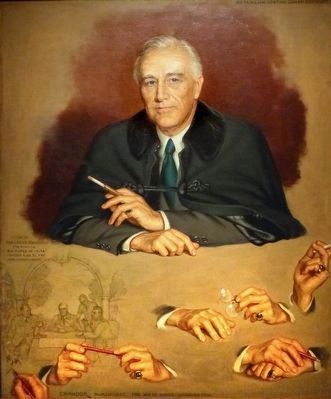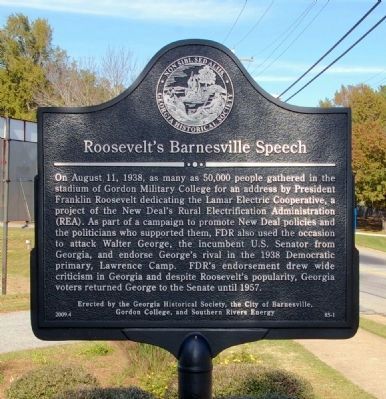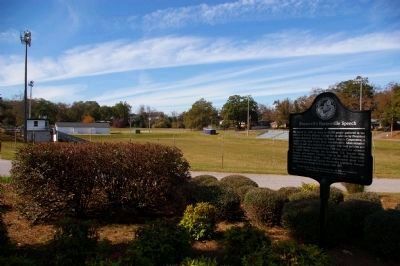Barnesville in Lamar County, Georgia — The American South (South Atlantic)
Roosevelt’s Barnesville Speech
Erected 2009 by Georgia historical Society, the City of Barnesville, Gordon College, and Southern Rivers Energy. (Marker Number 85-1.)
Topics and series. This historical marker is listed in these topic lists: Government & Politics • Industry & Commerce. In addition, it is included in the Former U.S. Presidents: #32 Franklin D. Roosevelt, the Georgia Historical Society, and the Rural Electrification 💡 series lists. A significant historical year for this entry is 1938.
Location. 33° 2.932′ N, 84° 9.2′ W. Marker is in Barnesville, Georgia, in Lamar County. Marker is at the intersection of College Drive and Summersfield Drive, on the left when traveling north on College Drive. The marker is located at the Georgia Military College Stadium. Touch for map. Marker is in this post office area: Barnesville GA 30204, United States of America. Touch for directions.
Other nearby markers. At least 8 other markers are within walking distance of this marker. Gordon Military College (approx. 0.2 miles away); A&M - G.I.C. (approx. 0.2 miles away); Old Jail Museum and Archives (approx. ¼ mile away); Lamar County Georgia Courthouse (approx. 0.3 miles away); Lamar County (Ga.) 20th Century War Veterans Memorial (approx. 0.3 miles away); Lamar County Veterans Memorial (approx. 0.3 miles away); In Memory of America's Revolutionary War Soldiers (approx. 0.3 miles away); Lamar County (approx. 0.3 miles away). Touch for a list and map of all markers in Barnesville.
Related markers. Click here for a list of markers that are related to this marker. To better understand the relationship, study each marker in the order shown.

Photographed By Allen C. Browne, February 16, 2015
3. Franklin D. Roosevelt
This 1945 Portrait of Franklin D. Roosevelt by Douglas Chandor hangs in the National Portrait Gallery in Washington, DC.
“When Franklin Roosevelt began serving in New York's state legislature in 1911, some observers declared him ill-suited to the rough realities of politics. But Roosevelt thrived on those realities; some two decades later, he was advancing from the New York governorship to the presidency.
Taking office against the bleak backdrop of the Great Depression, Roosevelt responded quickly to this economic disaster with a host of regulatory and welfare measures that redefined the government's role in American life. Among conservatives, the new federal involvement in matters traditionally left to the private sector was a betrayal of America's ideals. But in other quarters, Roosevelt's activism inspired an unwavering popularity that led to his election to an unprecedented four terms.
When Roosevelt sat for this portrait in 1945, his presidential concerns had long since shifted to guiding the nation through World War II. This likeness is a study for a larger painting a sketch of which appears at the lower left commemorating Roosevelt's meeting with wartime Allied leaders, Winston Churchill and Joseph Stalin at Yalta.” — National Portrait Gallery
“When Franklin Roosevelt began serving in New York's state legislature in 1911, some observers declared him ill-suited to the rough realities of politics. But Roosevelt thrived on those realities; some two decades later, he was advancing from the New York governorship to the presidency.
Taking office against the bleak backdrop of the Great Depression, Roosevelt responded quickly to this economic disaster with a host of regulatory and welfare measures that redefined the government's role in American life. Among conservatives, the new federal involvement in matters traditionally left to the private sector was a betrayal of America's ideals. But in other quarters, Roosevelt's activism inspired an unwavering popularity that led to his election to an unprecedented four terms.
When Roosevelt sat for this portrait in 1945, his presidential concerns had long since shifted to guiding the nation through World War II. This likeness is a study for a larger painting a sketch of which appears at the lower left commemorating Roosevelt's meeting with wartime Allied leaders, Winston Churchill and Joseph Stalin at Yalta.” — National Portrait Gallery
Credits. This page was last revised on November 16, 2019. It was originally submitted on December 17, 2009, by David Seibert of Sandy Springs, Georgia. This page has been viewed 1,510 times since then and 20 times this year. Last updated on March 6, 2010, by David Seibert of Sandy Springs, Georgia. Photos: 1, 2. submitted on December 17, 2009, by David Seibert of Sandy Springs, Georgia. 3. submitted on November 2, 2015, by Allen C. Browne of Silver Spring, Maryland. • Craig Swain was the editor who published this page.

